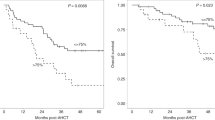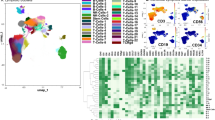Abstract
Autologous peripheral blood stem cell transplantation (PBSCT) for Hodgkin lymphoma (HL) is curative for many patients with relapsed or refractory disease. Relapsing disease, however, remains a major problem. Neoplastic transformation of B-lymphocytes probably underlies the development of classical HL. Whether clonal B cells are critical for disease evolution and response to therapy in HL remains uncertain. We investigated the impact of clonal B cells detected in peripheral blood stem cell (PBSC) collections on the outcome of patients with HL undergoing transplant. Qualitative semi-nested PCR was carried out on genomic DNA from mononuclear cells from PBSCs to determine the presence of clonal immunoglobulin heavy chain (IgH) complementary-determining region 3 (CDR3) gene rearrangements. Clinical factors were assessed for their association with relapse, overall survival (OS) and progression-free survival (PFS). Among 39 patients undergoing PBSCT, 12 grafts (31%) were PCR positive for clonal IgH rearrangements. OS was better in the PCR-negative group (logrank test, P=0.041). The OS at 5 years was 81% in PCR-negative versus 39% in PCR-positive patients; hazard ratio was 3.23 (95% confidence interval: 0.98–10.63). There was a trend towards better PFS (logrank test, P=0.12), estimated as 71% at 5 years in PCR-negative versus 41% in PCR-positive patients. Clonal B-lymphocytes in PBSC collections of patients with HL identify patients at risk of poor outcome. Larger series are needed to confirm our observations. Insight regarding the role of monoclonal B cells may lead to improved therapies.
This is a preview of subscription content, access via your institution
Access options
Subscribe to this journal
Receive 12 print issues and online access
$259.00 per year
only $21.58 per issue
Buy this article
- Purchase on Springer Link
- Instant access to full article PDF
Prices may be subject to local taxes which are calculated during checkout



Similar content being viewed by others
References
Sweetenham JW, Taghipour G, Milligan D, Blystad AK, Caballero D, Fassas A et al. High-dose therapy and autologous stem cell rescue for patients with Hodgkin's disease in first relapse after chemotherapy: results from the EBMT Lymphoma Working Party of the European Group for Blood and Bone Marrow Transplantation. Bone Marrow Transplant 1997; 20: 745.
Sureda A, Arranz R, Iriondo E, Carreras E, Lhuerta JJ, Garcia-Conde J et al. Autologous stem-cell transplantation for Hodgkin's disease: results and prognostic factors in 494 patients from the Grupo Espanol de Linfomas/Transplante atologo de Medula Osea Spanish Cooperative Group. J Clin Oncol 2001; 19: 1395–1404.
Lazarus HM, Loberiza FR, Zhang MJ, Armitage JO, Ballen KK, Bashey A et al. Autotransplants for Hodgkin's disease in first relapse or second complete remission: a report from the autologous blood and marrow transplant registry (ABMTR). Bone Marrow Transplant 2001; 21: 387–396.
Brice P, Bouabdallah R, Moreau P, Divine M, Andre M, Aoudjane M et al. Prognostic factors for survival after high-dose therapy and autologous stem cell transplantation for patients with relapsing Hodgkin's disease: analysis of 280 patients from the French registry. Societe Francaise de Greffe de Moelle. Bone Marrow Transplant 1997; 20: 21–26.
Kuppers R, Rajewsky K, Zhao M, Simons G, Laumann R, Fischer R et al. Hodgkin disease: Hodgkin and Reed–Sternberg cells picked from histological sections show clonal immunoglobulin gene rearrangements and appear to be derived from B cells at various stages of development. Proc Natl Acad Sci USA 1994; 91: 10962–10966.
Clodi K, Asgari Z, Younes M, Palmer JL, Cabanillas F, Carbone A et al. Expression of CD40 ligand (CD154) in B and T lymphocytes of Hodgkin disease: potential therapeutic significance. Cancer 2002; 94: 1–5.
Vockerodt M, Soares M, Kanzler H, Küppers R, Kube D, Hansmann ML et al. Detection of clonal Hodgkin and Reed–Sternberg cells with identical somatically mutated and rearranged VH genes in different biopsies in relapsed Hodgkin's disease. Blood 1998; 92: 2899–2907.
Wolf J, Kapp U, Bohlen H, Kornacker M, Schoch C, Stahl B et al. Peripheral blood mononuclear cells of a patient with advanced Hodgkin's lymphoma give rise to permanently growing Hodgkin–Reed Sternberg cells. Blood 1996; 87: 3418–3428.
Sukpanichnant S, Vnencak-Jones CL, McCurley TL . Determination of B-cell clonality in paraffin-embedded endoscopic biopsy specimens of abnormal lymphocytic infiltrates and gastrointestinal lymphoma by polymerase chain reaction. Am J Clin Pathol 1994; 102: 299–305.
Kaplan EL, Meier P . Nonparametric estimation from incomplete observations. J Am Stat Assoc 1958; 53: 457–481.
Hummel M, Ziemann K, Lammert H, Pileri S, Sabattini E, Stein H . Hodgkin's disease with monoclonal and polyclonal populations of Reed–Sternberg cells. N Engl J Med 1995; 333: 901–906.
Marafioti T, Hummel M, Foss HD, Laumen H, Korjuhn P, Anagnostopoulos I et al. Hodgkin and Reed–Sternberg cells represent an expansion of a single clone originating from a germinal center B-cell with functional immunoglobulin gene rearrangements but defective immunoglobulin transcription. Blood 2000; 95: 1443–1450.
Kyle RA, Therneau TM, Rajkumar SV, Offord JR, Larson DR, Plevak MF et al. A long-term study of prognosis in monoclonal gammopathy of undetermined significance. N Engl J Med 2002; 346: 564–569.
Schaar CG, le Cessie S, Snijder S, Franck PF, Wijermans PW, Ong C et al. Long-term follow-up of a population based cohort with monoclonal proteinaemia. Br J Haematol 2009; 144: 176–184.
Jones RJ, Gocke CD, Kasamon YL, Miller CB, Perkins B, Barber JP et al. Circulating clonotypic B cells in classical Hodgkin's lymphoma. Blood 2009; 113: 5920–5926.
Younes A, Romaquera J, Hagemeister F, McLaughlin P, Rodriguez MA, Fiumara P et al. A pilot study of rituximab in patients with recurrent, classic Hodgkin disease. Cancer 2003; 98: 310–314.
Oki Y, Pro B, Fayad LE, Romaguera J, Samaniego F, Hagemeister F et al. Phase 2 study of gemcitabine in combination with rituximab in patients with recurrent or refractory Hodgkin lymphoma. Cancer 2008; 112: 831–836.
Jarrett RF, Stark GL, White J, Angus B, Alexander FE, Krajewski AS J et al. Impact of tumor Epstein–Barr virus status on presenting features and outcome in age-defined subgroups of patients with classic Hodgkin lymphoma: a population-based study. Blood 2005; 106: 2444–2451.
Rassidakis GZ, Medeiros LJ, Vassilakopoulos TP, Viviani S, Bonfante V, Nadali G et al. BCL-2 expression in Hodgkin and Reed–Sternberg cells of classical Hodgkin disease predicts a poorer prognosis in patients treated with ABVD or equivalent regimens. Blood 2002; 100: 3935–3941.
Rassidakis GZ, Medeiros LJ, McDonnell TJ, Viviani S, Bonfonte V, Nadali G et al. BAX expression in Hodgkin and Reed Sternberg cells of Hodgkin's disease: correlation with clinical outcome. Clin Cancer Res 2002; 8: 488–493.
Rassidakis GZ, Medeiros LJ, Viviani S, Bonfoante V, Nadali GP, Vassilakopoulos TP et al. CD20 expression in Hodgkin and Reed–Sternberg cells of classical Hodgkin's disease: associations with presenting features and clinical outcome. J Clin Oncol 2002; 20: 1278–1287.
Landgren O, Engels EA, Pfeiffer RM, Gridley G, Mellemkjaer L, Olsen JH et al. Autoimmunity and susceptibility to Hodgkin lymphoma: a population-based case control study in Scandinavia. J Natl Cancer Inst 2006; 98: 1321–1330.
Kvarnstrom M, Sidorova E, Nilsson J, Ekerfelt C, Vrethem M, Soderberg O et al. Myelin protein P0-specific IgM producing monoclonal B cell lines were established from polyneuropathy patients with monoclonal gammopathy of undetermined significance. Clin Exp Immunol 2002; 127: 255–262.
Nakamura H, Usa T, Motomura M, Ichikawa T, Nakao K, Kawasaki E et al. Prevalence of interrelated autoantibodies in thyroid diseases and autoimmune disorders. J Endocrinol Invest 2008; 31: 861–865.
Nanan R, Strobel P, Haas JP, Marx A, Kreth HW . Autoimmune lymphoproliferative syndrome associated with severe humoral immunodeficiency and monoclonal gammopathy. Ann Hematol 2002; 81: 322–325.
Sharp JG, Chan WC . Detection and relevance of minimal disease in lymphomas. Cancer Metastasis Rev 1999; 18: 127–142.
Hasenclever D, Diehl V . A prognostic score for advanced Hodgkin's disease. International Prognostic Factors Project on Advanced Hodgkin's Disease. N Engl J Med 1998; 339: 1506–1514.
Horning SJ, Chao NJ, Negrin RS, Hoppe RT, Long GD, Hu WW et al. High dose therapy and autologous hematopoietic progenitor cell transplantation for recurrent or refractory Hodgkin's disease: Analysis of the Stanford university results and prognostic indices. Blood 1997; 89: 801–813.
Acknowledgements
DSA is an Adjunct Scientist with Canadian Blood Services and holds a New Investigator Award from Canadian Institutes of Health Research. The database of the Blood and Marrow Transplant (BMT) Program at The Ottawa Hospital is supported by The Ottawa Hospital Foundation BMT Research & Education Fund.
Author information
Authors and Affiliations
Corresponding author
Ethics declarations
Competing interests
The authors declare no conflict of interest.
Rights and permissions
About this article
Cite this article
Takach, S., Yang, L., Ho, J. et al. Monoclonal B cells detected in autologous PBSC grafts from patients with classical Hodgkin lymphoma: impact on relapse and survival following transplantation. Bone Marrow Transplant 45, 856–861 (2010). https://doi.org/10.1038/bmt.2009.241
Received:
Revised:
Accepted:
Published:
Issue Date:
DOI: https://doi.org/10.1038/bmt.2009.241



